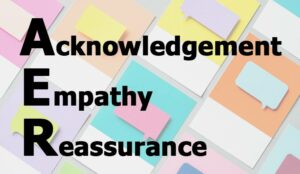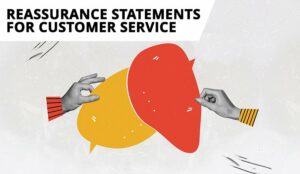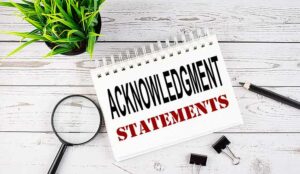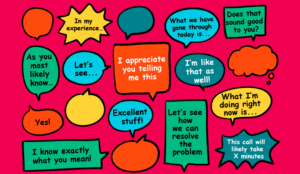AER statements can be a powerful tool for call centre agents, helping them navigate customer interactions more effectively and provide clear, empathetic responses.
In the fast-paced world of contact centres and BPOs (Business Process Outsourcing), where customer satisfaction is key, mastering AER statements can lead to more positive outcomes and improved service quality.
In this article, we’ll define what AER stands for, explore its significance in customer service, and provide practical examples of how agents can use these statements to enhance their conversations.
What Are AER Statements?
AER stands for ‘Acknowledgement’, ‘Empathy’, and ‘Reassurance’. Bringing these elements together into a series of connected phrases is a tried-and-tested way to help agents better manage difficult or upset customers.
As outlined below:
Acknowledgement
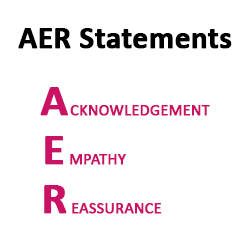
Recognising the customer’s issue or complaint. This shows the customer that you are listening and understand what they are saying.
For example, “I know how difficult it sometimes is to set up a new smartphone.”
Empathy
Show empathy for the customer’s situation. This helps in building a connection with the customer and demonstrating that you care about their problem.
For example, “I can see why you must be frustrated.”
Reassurance
Offer reassurance that steps will be taken to resolve the issue. This gives the customer confidence that their problem will be addressed.
For example, “The good news is you’re through to the right person and I’m more than happy to help guide you through the process”.
When to Use an AER Statement
The short answer = whenever appropriate.
An agent should be able to pick up on a customer’s tone, stress levels, anger, or frustration and gauge when it’s the right time to deliver an AER statement in response.
Call centre agents could benefit from using AER statements in these three scenarios –
1. Handling Complaints
When a customer calls with a complaint, applying the AER method can effectively manage their emotions and show that their concern is being taken seriously.
Example Scenario: A customer is upset about a billing error on their account.
2. De-escalating Situations
If a customer is angry or frustrated, using the AER technique can help calm them down and prevent the situation from escalating.
Example Scenario: A customer is irate because they were put on hold for too long.
3. Providing Support
When a customer is confused or needs assistance, acknowledging their confusion, empathizing with their situation, and reassuring them of support can greatly enhance their experience.
Example Scenario: A customer is having trouble understanding how to use a new product they purchased.
Five Examples of AER Statements for Customer Service
We have put together five examples of AER statements for customer service that your teams could use.
1. “I See There’s Been A Mistake On Your Billing Statement. I Can Understand How Confusing And Frustrating This Must Be. I’ll Review Your Account Right Now And Correct This Error For You.”
This AER statement can be used if the customer has called in about a billing error.
This statement immediately addresses the customer’s concern, showing that you are taking their issue seriously, then the empathy helps in calming the customer, making them feel understood and valued, before offering a specific solution that reassures the customer that their problem is being handled, which can reduce anxiety and build trust.
The statements used to acknowledge, empathise, and reassure are below:
- Acknowledge: “I see there’s been a mistake on your billing statement.”
- Empathise: “I can understand how confusing and frustrating this must be.”
- Reassure: “I’ll review your account right now and correct this error for you.”
2. “I Apologize For The Delay In Your Delivery. I Know How Important It Is To Receive Your Package On Time. I Will Track Your Package Immediately And Ensure It Gets To You As Soon As Possible.”
This sample statement can be used in a call centre if there is a late delivery.
This AER statement uses acknowledgment and an apology to diffuse the initial frustration, then the empathy demonstrates that you understand the impact of the delay on the customer, before providing reassurance and specific actions show proactive problem-solving, which helps in regaining customer trust.
This statement works as follows:
- Acknowledge: “I apologize for the delay in your delivery.”
- Empathise: “I know how important it is to receive your package on time.”
- Reassure: “I will track your package immediately and ensure it gets to you as soon as possible.”
3. “I Hear That You’re Having Trouble With Our Service. I Can Imagine How Frustrating It Must Be When The Service Isn’t Working As Expected. I’ll Connect You With Our Technical Support Team Right Away To Fix This Issue.”
This example AER statement can be used in a contact centre if the customer has experienced a technical issue.
This statement shows the customer that their issue is recognized and validated, then empathy helps in mitigating the customer’s frustration by showing that you understand their situation, before offering reassurance and quick redirection to the technical support team ensure that the customer feels supported and confident that their issue will be resolved.
You can see how each of the phrases is built into the AER framework:
- Acknowledge: “I hear that you’re having trouble with our service.”
- Empathise: “I can imagine how frustrating it must be when the service isn’t working as expected.”
- Reassure: “I’ll connect you with our technical support team right away to fix this issue.”
4. “I Apologize For The Long Wait You Experienced. I Know How Valuable Your Time Is, And Waiting Can Be Really Inconvenient. I’ll Make Sure To Assist You Promptly And Efficiently From Here On.”
This AER statement can be used if the customer has experienced a long wait time.
This statement works by apologising and acknowledging the wait time shows respect for the customer’s time, the using empathy to help in making the customer feel heard and valued, before providing reassurance and a promise of efficient service demonstrate a commitment to improving their experience, helping to rebuild trust.
The phrases used to acknowledge, empathise, and reassure are below:
- Acknowledge: “I apologize for the long wait you experienced.”
- Empathise: “I know how valuable your time is, and waiting can be really inconvenient.”
- Reassure: “I’ll make sure to assist you promptly and efficiently from here on.”
5. “I Hear That You’re Unhappy With Our Service. I Understand How That Can Be Frustrating And Disappointing. Let’s Discuss Your Concerns, And I’ll Do My Best To Find A Solution For You.”
This sample statement can be used for a general complaint.
This AER statement addresses the customer’s feelings of dissatisfaction directly, showing that you are listening, then the empathy helps in making the customer feel understood and valued, and ends with reassurance and a willingness to discuss and resolve their concerns show a proactive approach to customer service, which can help in regaining their trust and satisfaction.
This statement works as follows:
- Acknowledge: “I hear that you’re unhappy with our service.”
- Empathise: “I understand how that can be frustrating and disappointing.”
- Reassure: “Let’s discuss your concerns, and I’ll do my best to find a solution for you.”
If you are looking for more information on statements, read these articles next:
- The Top 10 Acknowledgement Statements for Customer Service and Difficult Situations
- Empathy Statements for Customer Service
- The Top 10 Reassurance Statements for Customer Service
Author: Megan Jones
Reviewed by: Robyn Coppell
Published On: 10th Feb 2023 - Last modified: 30th Jan 2025
Read more about - Skills, CX, Empathy, Language, Positive words





